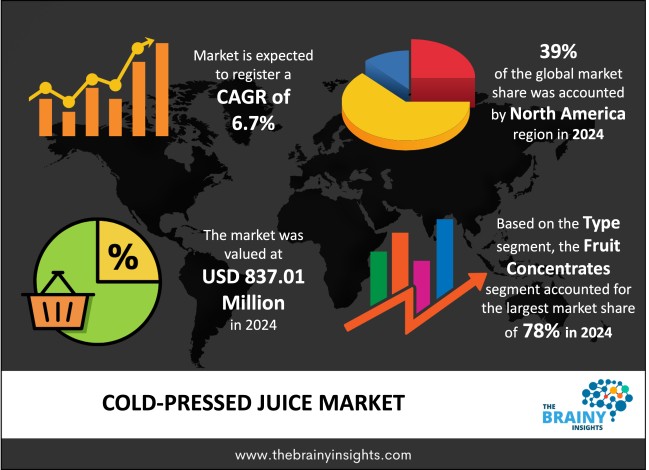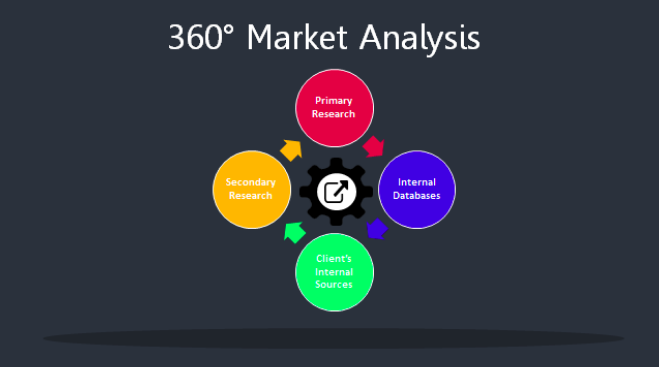- +1-315-215-1633
- sales@thebrainyinsights.com

The global cold-pressed juice market was valued at USD 837.01 Million in 2024 and grew at a CAGR of 6.7% from 2025 to 2034. The market is expected to reach USD 1,600.94 Million by 2034. Over the past decade, the global cold-pressed juice market has experienced significant growth, primarily driven by a surge in consumer awareness of health, wellness, and natural nutrition. Unlike conventional juice extraction methods that use heat, cold-pressed juices are made through hydraulic pressing, which retains essential nutrients, vitamins, and enzymes more effectively. This method makes them particularly appealing to health-conscious individuals. The expansion of this market is driven by an increasing demand for clean-label beverages—those that are organic and minimally processed—and provide functional benefits beyond basic hydration purposes. Today's consumers are actively seeking alternatives to sugary soft drinks and synthetic beverages; as a result, cold-pressed juices have become prominent within the natural and organic beverage sector. Cold-pressed juice is a type of fruit and vegetable beverage made through hydraulic pressing or cold press extraction. This process involves applying thousands of pounds of pressure to extract the juice without the use of heat or oxygen. Unlike traditional centrifugal juicers, which use rapidly spinning metal blades that generate frictional heat and may destroy essential nutrients, cold-pressing avoids thermal exposure and retains more vitamins, minerals, enzymes, and phytonutrients. Emphasizing minimal processing for maximum nutrient retention, this approach has become a crucial component of the health and wellness beverage industry.
The term "cold-pressed" refers both to the extraction process and the nutritional principles behind it. Essentially, cold-press juicing involves two main steps: first, raw fruits and vegetables are chopped or ground into a pulp using a slow masticating mechanism; then, this pulp is subjected to intense hydraulic pressure with specialised equipment that extracts juice while leaving a relatively dry fibre cake behind. Avoiding high temperatures is crucial for preserving heat-sensitive compounds, such as vitamin C, polyphenols, and live enzymes, so they remain active in the finished product. The cold-pressed method is known for producing a cleaner and fresher taste. Because the juice is extracted gently without using high-heat pasteurisation, it often results in a product with more vibrant colour, brighter flavour, and smoother texture compared to juices made with fast or heat-intensive techniques.

Get an overview of this study by requesting a free sample
Increasing Demand for Healthy Beverage – The global market for cold-pressed juice has surged due to a combination of strong and diverse factors, highlighting the increasing consumer demand for healthier, more natural beverage options. Leading these influences is the heightened global awareness of health and wellness, which has significantly altered consumer behaviour and dietary choices. The rising occurrences of lifestyle-related illnesses like obesity, diabetes, heart diseases, and digestive issues have fuelled public interest in nutrient-rich foods and drinks that promote preventive health benefits. Cold-pressed juices are valued for their high content of vitamins, minerals, antioxidants, and phytonutrients, offering an easy way to boost daily nutrition. This group of health-conscious consumers actively seeks products without artificial additives or excessive sugar but rich in essential nutrients—making cold-pressed juices an appealing alternative to traditional juices or sugary soft drinks. This factor contributes to the growth and development of the global cold-pressed juice market.
High production Costs – Although cold-pressed juices have rapidly gained popularity and become a staple of the health and wellness beverage market, the global industry still faces significant challenges that impact its scalability, profitability, and long-term sustainability. One of the most critical ongoing issues is the high production cost. This expense permeates throughout the supply chain, leading to premium retail prices. The process of extracting cold-pressed juice involves sophisticated hydraulic press equipment, slower processing cycles, and requires large quantities of raw produce for relatively small yields. Consequently, this results in higher input costs per unit compared to conventional juicing methods. Additionally, many products within this category depend on organic or pesticide-free fruits and vegetables—more expensive components—and also face complications due to seasonal variations. This factor is limiting the market growth and development.
Growing Urbanization and Increasing Disposable Income – The growing urbanization and rising disposable incomes in emerging markets are key drivers of the market. Rapid urban expansion, particularly in the Asia-Pacific and Latin America regions, is driving lifestyle shifts that prioritize convenience and health, creating a promising environment for the adoption of cold-pressed juices. In countries like China, India, Brazil, and Mexico, an expanding middle class is showing a growing readiness to invest in premium wellness products, such as cold-pressed juices. Urban consumers in these regions are increasingly recognizing the advantages of fresh, natural beverages over traditional sugary drinks and artificially flavoured options. This demographic transformation is further supported by enhanced retail infrastructure, such as the growth of modern supermarkets alongside health food stores and digital platforms that facilitate access to cold-pressed juice offerings through e-commerce channels. This factor is anticipated to provide lucrative growth opportunities in the upcoming years.
The regions analyzed for the market include North America, Europe, South America, Asia Pacific, the Middle East, and Africa. North America emerged as the most significant global cold-pressed juice market, with a 39% market revenue share in 2024.
The region, primarily encompassing the U.S. and Canada, being U.S. as a significant contributor towards the regional market growth and development. North America continues to dominate the market for cold-pressed juice, holding the largest regional share thanks to its well-established health beverage sector and widespread consumer awareness of health trends. In both the U.S. and Canada, cold-pressed juices have become an integral part of a larger wellness lifestyle that emphasizes clean eating, fitness, and preventive healthcare. The region is home to many brands—such as BluePrint, Suja, and Pressed Juicery—which have significantly contributed to consumer acceptance and availability through direct-to-consumer subscriptions, collaborations with wellness retailers, partnerships, and distribution in grocery stores. In the U.S., particularly, cold-pressed products are prominently featured on shelves at Whole Foods, Sprouts, and other stores that emphasize healthy products, thereby increasing brand visibility while promoting sampling-driven growth among consumers.
North America Region Cold-pressed juice Market Share in 2024 - 39%
www.thebrainyinsights.com
Check the geographical analysis of this market by requesting a free sample
The type segment is divided into fruit concentrates and vegetable concentrates. The fruit concentrates segment dominated the market, with a market share of around 78% in 2024. The natural sweetness and familiar taste of fruit concentrates in cold-pressed juices appeal to consumers from diverse age groups and regions. Advances in concentrate production now enable the preservation of natural sugars, vitamin C, and antioxidants, aligning with health-oriented trends that prioritise clean labelling. Additionally, fruit concentrates are often mixed with vegetable concentrates and functional ingredients to develop distinctive cold-pressed juice formulas targeting the wellness and detox markets. The natural sweetness of fruit concentrates helps offset the typically bitter or earthy flavours of vegetable concentrates, enhancing taste appeal and consumer acceptance.
The category segment is divided into conventional and organic. The conventional segment dominated the market, with a market share of around 68% in 2024. Conventional juices are popular primarily because they tend to be more affordable, widely available, and familiar to mainstream consumers. This category of juices includes cold-pressed varieties made from conventionally grown fruits and vegetables that may have been treated with pesticides, herbicides, and synthetic fertilisers during cultivation. However, the cold-pressing method retains most of the nutritional value without adding harmful processing chemicals. People who choose conventional cold-pressed juices often do so for their fresh taste, combined with minimal processing, rather than a focus on organic qualities. The segment primarily attracts younger individuals new to these beverages or those seeking cost-effective options while enjoying convenience and flavour.
The distribution channel segment is divided into hypermarkets and supermarkets, convenience stores, online sales and others. The roadways segment dominated the market, with a market share of around 42% in 2024. In developed markets such as the U.S., Canada, the UK, Germany, and Australia, top retailers, including Walmart, Tesco, Carrefour, and Whole Foods, have expanded their health beverage selections to feature an extensive range of cold-pressed juice SKUs. These include everything from pure fruit blends to detox and immunity-enhancing formulas. Cold-pressed juices typically hold premium positions next to functional waters, kombucha drinks and plant-based milk, which strengthens the perception of them as a healthy option. Shoppers in hypermarkets and supermarkets value the opportunity to compare different cold-pressed juice brands, examine labels, and buy fresh items during their regular grocery trips. Impulse purchases are often driven by the strategic placement of juices near checkout counters or deli areas. Additionally, these retail settings often offer competitive prices, bundled deals, and loyalty rewards that encourage both trial and repeat purchasing behaviours.
| Attribute | Description |
|---|---|
| Market Size | Revenue (USD Million) |
| Market size value in 2024 | USD 837.01 Million |
| Market size value in 2034 | USD 1,600.94 Million |
| CAGR (2025 to 2034) | 6.7% |
| Historical data | 2021-2023 |
| Base Year | 2024 |
| Forecast | 2025-2034 |
| Region | The regions analyzed for the market are Asia Pacific, Europe, South America, North America, and Middle East and Africa. Furthermore, the regions are further analyzed at the country level. |
| Segments | Type, Category, and Distribution Channel |
As per The Brainy Insights, the size of the global cold-pressed juice market was valued at USD 837.01 million in 2024 to USD 1,600.94 million by 2034.
Global cold-pressed juice market is growing at a CAGR of 6.7% during the forecast period 2025-2034.
The market's growth will be influenced by growing popularity of organic juice amongst consumers.
High production costs could hamper the market growth.
This study forecasts revenue at global, regional, and country levels from 2021 to 2034. The Brainy Insights has segmented the global Cold-pressed Juice market based on below mentioned segments:
Global Cold-pressed Juice Market by Type:
Global Cold-pressed Juice Market by Category:
Global Cold-pressed Juice Market by Distribution Channel:
Global Cold-pressed Juice Market by Region:
Research has its special purpose to undertake marketing efficiently. In this competitive scenario, businesses need information across all industry verticals; the information about customer wants, market demand, competition, industry trends, distribution channels etc. This information needs to be updated regularly because businesses operate in a dynamic environment. Our organization, The Brainy Insights incorporates scientific and systematic research procedures in order to get proper market insights and industry analysis for overall business success. The analysis consists of studying the market from a miniscule level wherein we implement statistical tools which helps us in examining the data with accuracy and precision.
Our research reports feature both; quantitative and qualitative aspects for any market. Qualitative information for any market research process are fundamental because they reveal the customer needs and wants, usage and consumption for any product/service related to a specific industry. This in turn aids the marketers/investors in knowing certain perceptions of the customers. Qualitative research can enlighten about the different product concepts and designs along with unique service offering that in turn, helps define marketing problems and generate opportunities. On the other hand, quantitative research engages with the data collection process through interviews, e-mail interactions, surveys and pilot studies. Quantitative aspects for the market research are useful to validate the hypotheses generated during qualitative research method, explore empirical patterns in the data with the help of statistical tools, and finally make the market estimations.
The Brainy Insights offers comprehensive research and analysis, based on a wide assortment of factual insights gained through interviews with CXOs and global experts and secondary data from reliable sources. Our analysts and industry specialist assume vital roles in building up statistical tools and analysis models, which are used to analyse the data and arrive at accurate insights with exceedingly informative research discoveries. The data provided by our organization have proven precious to a diverse range of companies, facilitating them to address issues such as determining which products/services are the most appealing, whether or not customers use the product in the manner anticipated, the purchasing intentions of the market and many others.
Our research methodology encompasses an idyllic combination of primary and secondary initiatives. Key phases involved in this process are listed below:

The phase involves the gathering and collecting of market data and its related information with the help of different sources & research procedures.

The data procurement stage involves in data gathering and collecting through various data sources.
This stage involves in extensive research. These data sources includes:
Purchased Database: Purchased databases play a crucial role in estimating the market sizes irrespective of the domain. Our purchased database includes:
Primary Research: The Brainy Insights interacts with leading companies and experts of the concerned domain to develop the analyst team’s market understanding and expertise. It improves and substantiates every single data presented in the market reports. Primary research mainly involves in telephonic interviews, E-mail interactions and face-to-face interviews with the raw material providers, manufacturers/producers, distributors, & independent consultants. The interviews that we conduct provides valuable data on market size and industry growth trends prevailing in the market. Our organization also conducts surveys with the various industry experts in order to gain overall insights of the industry/market. For instance, in healthcare industry we conduct surveys with the pharmacists, doctors, surgeons and nurses in order to gain insights and key information of a medical product/device/equipment which the customers are going to usage. Surveys are conducted in the form of questionnaire designed by our own analyst team. Surveys plays an important role in primary research because surveys helps us to identify the key target audiences of the market. Additionally, surveys helps to identify the key target audience engaged with the market. Our survey team conducts the survey by targeting the key audience, thus gaining insights from them. Based on the perspectives of the customers, this information is utilized to formulate market strategies. Moreover, market surveys helps us to understand the current competitive situation of the industry. To be precise, our survey process typically involve with the 360 analysis of the market. This analytical process begins by identifying the prospective customers for a product or service related to the market/industry to obtain data on how a product/service could fit into customers’ lives.

Secondary Research: The secondary data sources includes information published by the on-profit organizations such as World bank, WHO, company fillings, investor presentations, annual reports, national government documents, statistical databases, blogs, articles, white papers and others. From the annual report, we analyse a company’s revenue to understand the key segment and market share of that organization in a particular region. We analyse the company websites and adopt the product mapping technique which is important for deriving the segment revenue. In the product mapping method, we select and categorize the products offered by the companies catering to domain specific market, deduce the product revenue for each of the companies so as to get overall estimation of the market size. We also source data and analyses trends based on information received from supply side and demand side intermediaries in the value chain. The supply side denotes the data gathered from supplier, distributor, wholesaler and the demand side illustrates the data gathered from the end customers for respective market domain.

The supply side for a domain specific market is analysed by:
The demand side for the market is estimated through:
In-house Library: Apart from these third-party sources, we have our in-house library of qualitative and quantitative information. Our in-house database includes market data for various industry and domains. These data are updated on regular basis as per the changing market scenario. Our library includes, historic databases, internal audit reports and archives.
Sometimes there are instances where there is no metadata or raw data available for any domain specific market. For those cases, we use our expertise to forecast and estimate the market size in order to generate comprehensive data sets. Our analyst team adopt a robust research technique in order to produce the estimates:
Data Synthesis: This stage involves the analysis & mapping of all the information obtained from the previous step. It also involves in scrutinizing the data for any discrepancy observed while data gathering related to the market. The data is collected with consideration to the heterogeneity of sources. Robust scientific techniques are in place for synthesizing disparate data sets and provide the essential contextual information that can orient market strategies. The Brainy Insights has extensive experience in data synthesis where the data passes through various stages:


Market Deduction & Formulation: The final stage comprises of assigning data points at appropriate market spaces so as to deduce feasible conclusions. Analyst perspective & subject matter expert based holistic form of market sizing coupled with industry analysis also plays a crucial role in this stage.
This stage involves in finalization of the market size and numbers that we have collected from data integration step. With data interpolation, it is made sure that there is no gap in the market data. Successful trend analysis is done by our analysts using extrapolation techniques, which provide the best possible forecasts for the market.
Data Validation & Market Feedback: Validation is the most important step in the process. Validation & re-validation via an intricately designed process helps us finalize data-points to be used for final calculations.

The Brainy Insights interacts with leading companies and experts of the concerned domain to develop the analyst team’s market understanding and expertise. It improves and substantiates every single data presented in the market reports. The data validation interview and discussion panels are typically composed of the most experienced industry members. The participants include, however, are not limited to:
Moreover, we always validate our data and findings through primary respondents from all the major regions we are working on.
Free Customization
Fortune 500 Clients
Free Yearly Update On Purchase Of Multi/Corporate License
Companies Served Till Date